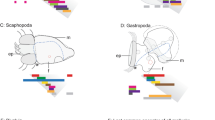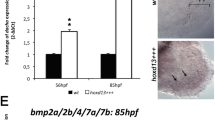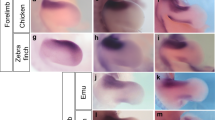Abstract
HOX genes are essential for growth and patterning of the tetrapod limb skeleton1–5. Mice mutant for the Hoxd-13gene have an important delay in morphogenesis owing to reduced proliferation2. Based on the appearance of atavisms in such mice, we suggested that modifications of Hox gene regulation may have been a source of morphological variation during the evolution of tetrapod limbs2,6. Pectoral and pelvic fins are homologous to fore- and hind-limbs, respectively. To compare the relative importance of Hox genes during fin versus limb morphogenesis, we cloned zebrafish (Danio rerio) HoxD and HoxA complex genes and analysed their expression during fin development. The results suggest a scheme for the fin–limb transition in which the distal autopods (digits) are neomorphic structures produced by unequal proliferation of the posterior part of an ancestral appendix.
This is a preview of subscription content, access via your institution
Access options
Subscribe to this journal
Receive 51 print issues and online access
$199.00 per year
only $3.90 per issue
Buy this article
- Purchase on Springer Link
- Instant access to full article PDF
Prices may be subject to local taxes which are calculated during checkout
Similar content being viewed by others
References
Dollé, P., Izpsiúa-Belmonte, J.-C., Falkenstein, H., Renucci, A. & DuBoule, D. Nature 342, 767–772 (1989).
Dollé, P. et al. Cell 75, 431–441 (1993).
Davis, A. P. & Capecchi, M. R. Development 120, 2187–2199 (1994).
Small, K. M. & Potter, S. S. Genes Dev. 7, 2318–2328 (1993).
Favier, B., Le Meur, M., Chambon, P. & Dollé, P. Proc. natn. Acad. Sci. U.S.A. 92, 310–314 (1995).
Duboule, D. Development (suppl.), 135–142 (1994).
Hinchliffe, J. R. & Johnson, D. R. The Development of the Vertebrate Limb (Clarendon, Oxford, 1980).
Shubin, N. H. & Alberch, P. in Evolutionary Biology (eds Hecht, M. K., Wallace, B. & Prance, G. I.) 319 (Plenum, New York, 1986).
Tabin, C. J. Cell, 66, 199–217 (1991).
Tickle, C. Development (suppl.) 1, 113–121 (1991).
Summerbell, D., Lewis, J. H. & Wolpert, L. C. J. Nature 244, 492–496 (1973).
Izpisua-Belmonte, J.-C. & Duboule, D. Devl Biol. 152, 26–36 (1992).
Yokouchi, Y., Sasaki, H. & Kunoiwa, A. Nature 353, 443–445 (1991).
Haack, H. & Gruss, P. Devl Biol. 157, 410–422 (1993).
Coates, M. I. Development (suppl.), 169–180 (1994).
Ahlberg, P. E. & Milner, A. R. Nature 368, 507–512 (1994).
Dane, P. J. & Tucker, J. B. J. Embryol. exp. Morph. 87, 145–161 (1985).
Géraudie, J. Acta. zool. Stockh. 59, 85–96.
Potthoff, T. & Tellock, J. A. Bull. mar. Sci. 52, 669–716 (1993).
Krauss, S., Concordet, J. P. & Ingham, P. Cell 75, 1431–1444 (1993).
Riddle, R. D., Johnson, R. L., Laufer, E. & Tabin, C. J. Cell 75, 1401–1416 (1993).
Laufer, E., Nelson, C. E., Johnson, R. L., Morgan, B. & Tabin, C. J. Cell 79, 993–1003 (1994).
Thorogood, P. in Developmental Patterning of the Vertebrate Limb (eds Hinchliffe, J. R., Huerle J. M. & Summerbell, D.) 347–354 (Plenum, New York, 1991).
Duboule, D. Science 266, 575–576 (1994).
Niswander, L., Jeffrey, S., Martin, G. R. & Tickle, C. Nature 371, 609–612 (1994).
Coates, M. in Developmental Patterning of the Vertebrate Limb (eds Hinchliffe, J. R., Huerle, J. M. & Summerbell, D.) 328–338 (Plenum, New York, 1991).
Holmgreen, N. Acta zool. Stockh. 33, 1–115 (1952).
Shubin, N. in Evolutionary Biology (eds Hecht, M. K., Macintyre, R. J. & Clegg, M. T.) 39–86 (Plenum, New York, 1995).
Streisinger, G., Singer, F., Walker, C., Knauber, D. & Dower, N. Genetics 112, 311–319 (1981).
Strähle, U. & Ingham, P. W. Zebrafish Sci. Monitor 2, 5–7 (1993).
Author information
Authors and Affiliations
Rights and permissions
About this article
Cite this article
Sordino, P., van der Hoeven, F. & Duboule, D. Hox gene expression in teleost fins and the origin of vertebrate digits. Nature 375, 678–681 (1995). https://doi.org/10.1038/375678a0
Received:
Accepted:
Issue Date:
DOI: https://doi.org/10.1038/375678a0
This article is cited by
-
Hoxd13/Bmp2-mediated mechanism involved in zebrafish finfold design
Scientific Reports (2021)
-
Expression of meis and hoxa11 in dipnoan and teleost fins provides new insights into the evolution of vertebrate appendages
EvoDevo (2018)
-
A conserved Shh cis-regulatory module highlights a common developmental origin of unpaired and paired fins
Nature Genetics (2018)
-
Limb development: a paradigm of gene regulation
Nature Reviews Genetics (2017)
-
The crucial role and regulations of miRNAs in zebrafish development
Protoplasma (2017)
Comments
By submitting a comment you agree to abide by our Terms and Community Guidelines. If you find something abusive or that does not comply with our terms or guidelines please flag it as inappropriate.



